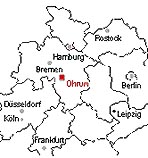A History of the Ohrum Name
The town of Ohrum is part of the municipality known as Oderwald in the southern part of the German state of Lower Saxony. Oderwald has a total area of approximately 35 square miles, 7000 inhabitants and is made up of seven villages: Ohrum, Heiningen, Floethe, Dorstadt, Cramme, Boerssum and Achim. The town of Ohrum has approximately 500 inhabitants and is a 4-hour drive to the north of Frankfurt, Germany, approximately 200 miles.
Town limit at the Oker River

Ohrum is located on the west bank of the Oker River, which was the border between the Halberstadt and the Hildesheim catholic dioceses between 814 and 827 A.D.
Oderwald is mostly a farming area but is also well known for its scenery and as a recreational haven.
In 780 A.D., Karl the Great introduced Christianity (by force) to the Saxonian residents. The first baptisms in this forced conversion were performed on the Oker River at Ohrum. In the 12th century, many monasteries were founded in the Oderwald area, some of which are still standing today and are open to the public.
Medieval church in Ohrum

In 1997, Professor Dr. J. Udolph published The Place Named Ohrum, 747-1997. In this paper, he attempted to document the word Ohrum as it relates to current and medieval languages.
Although he admits that his research was not conclusive as to the exact origin of the word, parts of his research shed some light on the possible origins of the family name Ohrum: Family names have only been in existence for the last five or six centuries. It is a common assumption that family names originated either from one’s trade, or from the name of the place from which one came. Based on this, one can reasonably assume the family name of Ohrum originated in the place named Ohrum.
Dr. Udolph’s research lists names such as Arem, Orem, Horum and Orum appearing as early as the 12th century for the town in Germany presently known as Ohrum. He attributes the introduction of the "h" in Orum to the lengthening of the pronunciation of the vowel "o," based on the theory that the spelling of most words was changed over time to fit the pronunciation used in the local dialects.
The present spelling first appeared in 1568, corresponding to the time when family names first started to be used, fitting the theory that, at some point after 1568, a man from Ohrum needing a second, or family name, took the name of his hometown.
Dr. Udolph’s research also provides an extensive evaluation of the meaning of the word Ohrum. Based on his research, the most likely origin is from an ancient Germanic language.
Germanic is a term used to describe old Nordic, and other languages, considered to be sister languages to German. Pieces of these languages are still evident in modern words in languages such as Danish, Swedish and German, although specific words have disappeared. Dr. Udolph’s research documents words in as many as three ancient Germanic languages that could have evolved into the word Ohrum. Almost all of these words have meanings relating to water and the surrounding landmasses. From the many words listed in his research, the most logical conclusion is that Ohrum comes from various ancient words meaning "village or home on a sand bank near a body of water" or, since the body of water is named the Oker, Village on the Oker River.
December 1999

|


